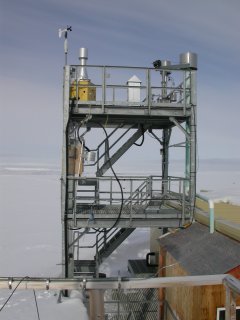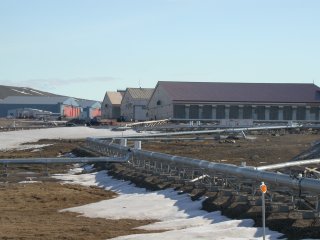Early breakfast again today – the long weekend was over (what weekend?). After that I wanted to head out to the SST right away, but – alas – Nuuk, my trusty truck, would not start. So I called for help and got some power from a working battery. Once arrived at the TX Site, I plugged it in to keep the engine warm. So I hauled my equipment of the day incl. some food with a sled to the SST and started working. Bio-sampler, snow-sampling,… but no power yet.

That did not change after 2 visits from the electricians (driving their BV right up the the trailer *arrgl*). Some part in the transformer was dead – and they had to check back to see, if it was available or had to be flown in. I also had my first shot at using the radio with the Hydro guys. Well – no power and so I got the sled again and hauled the MOUDI to the GAW Lab and set it up there. If I do not get power soon, I will move to the GAW Lab altogether, although I find the trailer very practical. Setting the MOUDI up at the GAW Lab was fine. At some point I had to head back to the SST to finish up there (snow sampling, air sampling, shutting down the bio-sampler) and then back again to the Lab to finish the MOUDI measurements. I am a bit skeptical about storing substrates in Petri- dishes, but there seems to be no other way. Especially avoiding vibrations, which causes particles to bounce around the dish and off the substrate, will be difficult, when getting the samples back with the truck and flying them down South.
Anyway – a busy day and it was getting late – not that it mattered, when there are 24 hours of daylight. Getting back before dark is not a good resolution for the day in these latitudes; anyway, it was 8 pm, when I parked the truck at Polaris Hall (it started fine at the TX site and I was spared the use of the Sat-phone). I fired up the GC to run the SPME samples and prepared the Bio-sampler for its next run.
